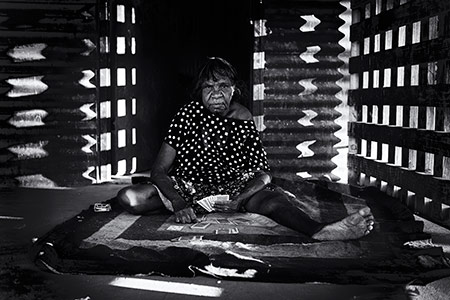This Is My Country
Opening Saturday April 30, 3–5pm
Artist/Photographer: Ingetje Tadros
Featured Show Head On Photo Festival
Photographer Ingetje Tadros has been living in Broome for twelve years. Five years ago she picked up the camera and recorded what she saw in the indigenous communities in and around Broome. The results are strong and confronting to a white population who believe their government is doing all it can for Aboriginal people in this country.
These photographs are strong and uncompromising in their portrayal of how things are in certain parts of Australia, a country we value for its egalitarianism. The treatment of indigenous cultures is shameful not only in Australia (all over the world) and Australia is judged internationally. Yet we as white Australians are protected from seeing the way things truly are.
These images will go a long way to change that. I believe that we are mature enough as a nation to be shown this reality in 2016.
Curator Sandy Edwards
Ingetje Tadros says “I have always been appalled by the way Aboriginal people were treated. It disturbed and disgusted me, so I decided to have a closer look and started mingling with Aboriginal people about five years ago. At first I spent time in the small bush camps where they were carving Boab nuts and were eating and drinking then started taking portraits. I always gave them the images and they were received with a big smile that was my reward. We started a relationship that became stronger and more intense. I documented daily life such as funerals, hunting, family fights, a wedding and little family moments. Then seven months ago I felt the need to document just one community, Kennedy Hill, which was one of the communities facing Closure. Many Aboriginal people are appalled and shocked by the decision of the Premier of Western Australia Colin Barnett, about his decisions to close at least 100 communities in Western Australia.
I was appalled that people are living in such poverty in a country like Australia, which is so rich. People are living in very old and unmaintained houses in Broome, a tourist mecca, where people fly in from all over the world to enjoy this beautiful place. The community of Kennedy Hill seemed to me like a different planet situated on ‘pristine real estate’ and I was annoyed about the negativity expressed toward Aboriginal people. I believe that when there are different cultures living together, they should sit and learn from each other and respect each other’s cultures and ways. This is the only way forward.
Closing down communities similar to Kennedy Hill is devastating for the people who live in them. It represents a painful physical, emotional, spiritual disconnect for Aboriginal people from their sacred land. I documented the Kennedy Hill community because it is representative of the widespread decimation of Indigenous peoples communities in remote Australia. These photos are evidence of a poverty stricken people who have long endured systemic social and historical human rights abuses. The statics are alarming. Over seven percent of the Kimberley population is homeless, and a staggering ninety percent of this homelessness is comprised of Indigenous people who in the Kimberley and all remote communities are confronted with the physical loss of their communities. As confronting as some of my photographs are here, I hope that they will communicate the plight of the people in communicate the plight of the people in them and act as a catalyst for debate and an agent for social change no matter how small.
Opening Saturday 30 April 3 – 5pm
Exhibition continues until Sunday 8 May
Gallery open Tuesday – Saturday 11am – 6pm Sunday 11am – 5pm


